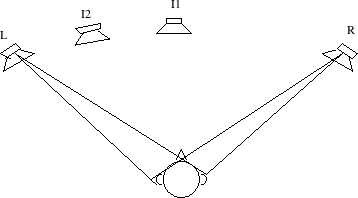Directional cues may be provided by
- using several loudspeakers;
- creating an illusion.
- a listener positioned equidistant from two loudspeakers L
and R receives equal signal in each ear;
- the illusion is of a source centered at I1.
Figure 5:
Listener positioned equidistant from two
loudspeakers.
|
 |
- delaying the signal applied to loudspeaker R (equivalent to
moving R farther to the right) causes the sound to reach the left ear first;
- the illusion is of a source location shifted to I2.
Simulating ITD cues requires very contrived conditions
(e.g. headphones or a fixed position).
``Music 175: Space''
by Tamara Smyth,
Department of Music, University of California, San Diego (UCSD).
Download PDF version (space175.pdf)
Download compressed PostScript version (space175.ps.gz)
Download PDF `4 up' version (space175_4up.pdf)
Download compressed PostScript `4 up' version (space175_4up.ps.gz)
Copyright © 2019-04-16 by Tamara Smyth.
Please email errata, comments, and suggestions to Tamara Smyth<trsmyth@ucsd.edu>